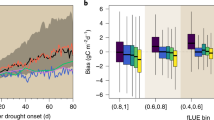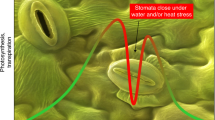Abstract
Monthly data from the moderate resolution imaging spectroradiometer (MODIS) and its predecessor satellite sensors was used to reconstruct vegetation dynamics in response to climate patterns over the period 1983–2005. Results suggest that plant growth over extensive land areas of southern Africa and Central Asia were the most closely coupled of any major land area to El Niño–southern oscillation (ENSO) effects on regional climate. Others land areas strongly tied to recent ENSO climate effects were in northern Canada, Alaska, western US, northern Mexico, northern Argentina, and Australia. Localized variations in precipitation were the most common controllers of monthly values for the fraction absorbed of photosynthetically active radiation (FPAR) over these regions. In addition to the areas cited above, seasonal FPAR values from MODIS were closely coupled to rainfall patterns in grassland and cropland areas of the northern and central US. Historical associations between global vegetation FPAR and atmospheric carbon dioxide (CO2) anomalies suggest that the terrestrial biosphere can contribute major fluxes of CO2 during major drought events, such as those triggered by 1997–1998 El Niño event.





Similar content being viewed by others
References
Buermann W, Anderson B, Tucker CJ, Dickinson RE, Lucht W, Potter CS, Myneni RB (2003) Interannual co-variability in northern hemisphere air temperatures and greenness associated with ENSO and AO. J Geophys Res 108(D13):4396, doi:10.1029/2002JD002630
Chatfield C (1996) The analysis of time series: an introduction, 5th edn, Chapman and Hall/CRC, London/Boca Raton, p 140
Cox PM, Betts RA, Jones CD, Spall SA, Totterdell IJ (2000) Acceleration of global warming due to carbon cycle feedbacks in a coupled climate model. Nature 408:184–187
Cramer W et al (2001) Global response of terrestrial ecosystem structure and function to CO2 and climate change: results from six dynamic global vegetation models. Glob Chang Biol 7:357–373
Dai A, Trenberth KE, Karl TR (1998) Global variations in droughts and wet spells: 1900–1995. Geophys Res Lett 25:3367–3370
Feely RA, Wanninkhof R, Takahashi T, Tans P (1999) Influence of El Niño on the equatorial Pacific contribution to atmospheric CO2 accumulation. Nature 398:597–601
Foley JA, Botta A, Coe MT, Costa MH (2000) El Nino––southern oscillation and the climate, ecosystems and rivers of Amazonia. Global Biogeochem Cycles 16(4):1132, doi:10.1029/2002GB001872
Friedl MA, McIver DK, Hodges JCF, Zhang X, Muchoney D, Strahler AH, Woodcock CE, Gopal S, Schnieder A, Cooper A, Baccini A, Gao F, Schaaf C (2002) Global land cover from MODIS: algorithms and early results. Remote Sens Environ 83:135–148
Geider R, DeLucia E, Falkowski P, Finzi A, Grime J, Grace J, Kana T, La Roche J, Long S, Osborne B, Platt T, Prentice I, Raven J, Schlesinger W, Smetacek V, Stuart V, Sathyendranath S, Thomas R, Vogelmann T, Williams P, Woodward F (2001) Primary productivity of planet earth: biological determinants and physical constraints in terrestrial and aquatic habitats. Glob Chang Biol 7:849–882
Gillett NP, Weaver AJ, Zwiers FW, Flannigan MD (2004) Detecting the effect of climate change on Canadian forest fires. Geophys Res Lett 31(18):L18211, doi:10.1029/2004GL020876
Glantz MH, Katz RW, Nicholls N (eds.) (1991) Teleconnections linking world-wide climate anomalies. Cambridge University Press, New York, p 527
Higgins RW, Zhou Y, Kim H-K (2001) Relationships between El Niño––southern oscillation and the Arctic oscillation: a climate–weather link. NCEP/Climate Prediction Center ATLAS 8 (http://www.cpc.noaa.gov/research_papers/ncep_cpc_atlas)
Hurrell JW (1995) Decadal trends in the North Atlantic oscillation regional temperatures and precipitation. Science 269:676–679
IPCC, Climate Change (2001) The scientific basis, contribution of working group I to the third assessment report of the intergovernmental panel on climate change (IPCC). In: J. T. Houghton, Y. Ding, D.J. Griggs, M. Noguer, P. J. van der Linden and D. Xiaosu (Eds.) Cambridge University Press, UK, p 944
Kasischke ES, Hyer EJ, Novelli PC, Bruhwiler LP, French NHF, Sukhinin AI, Hewson JH, Stocks BJ (2005) Influences of boreal fire emissions on northern hemisphere atmospheric carbon and carbon monoxide, Global Biogeochem Cycles 19. doi:10.1029/2004GB002300
Katz RW (1988) Use of cross correlations in the search for teleconnections. J Climatol 8:241–253
Keeling CD, Whorf TP (2004) Atmospheric CO2 concentrations (ppmv) derived from in situ air samples collected at Mauna Loa Observatory, Hawaii. In: Trends: a compendium of data on global change, on line at the Carbon Dioxide Information Analysis Center [http://cdiac.esd.ornl.gov/ftp/maunaloa-co2/maunaloa.co2]
Keeling CD, Whorf TP, Wahlen M, van der Plicht J (1995) Interannual extremes in the rate of rise of atmospheric carbon dioxide. Nature 375:666–670
Keeling CD, Chin JFS, Whorf TP (1996) Increased activity of northern vegetation inferred from atmospheric CO2 measurements. Nature 382:146–149
Kistler R, Kalnay E, Collins W, Saha S, White G, Woollen J, Chelliah M, Ebisuzaki W, Kanamitsu M, Kousky V, van den Dool H, Jenne R, Fiorino M (2001) The NCEP-NCAR 50-year reanalysis: monthly means CD-ROM and documentation. Bull Am Meteor Soc 82:247–268
Knorr W, Gobron N, Scholze M, Kaminski T, Pinty B (2005) Global-scale drought caused atmospheric CO2 increase. EOS Trans 86(18):178, 181
Knyazikhin Y, Martonchik JV, Myneni RB, Diner DJ, Running SW (1998) Synergistic algorithm for estimating vegetation canopy leaf area index and fraction of absorbed photosynthetically active radiation from MODIS and MISR data. J Geophys Res 103:32,257–32,276
Lagerloef G, Lukas R, Bonjean F, Gunn J, Mitchum G, Bourassa M, Busalacchi AJ (2003) El Niño Tropical Pacific Ocean surface current and temperature evolution in 2002 and outlook for early 2003. Geophys Res Lett 30:1514, doi:10.1029/2003GL017096
Los SO, Collatz GJ, Bounoua L, Sellers PJ, Tucker CJ (2001) Global interannual variations in sea surface temperature and land surface vegetation, air temperature, and precipitation. J Clim 14:1535–1549
Lucht W, Prentice IC, Myneni RB, Sitch S, Friedlingstein P, Cramer W, Bousquet P, Buermann W, Smith B (2002) Climatic control of the high-latitude vegetation greening trend and Pinatubo effect. Science 296:1687–1689
Mason SJ, Goddard L (2001) Probabilistic precipitation anomalies associated with ENSO. Bull Am Meteorol Soc 82:619–638
McCabe GJ, Dettinger MD (1999) Decadal variations in the strength of ENSO teleconnections with precipitation in the western United States. Int J Climatol 19:1399–1410
McPhaden MJ (2004) Evolution of the 2002/03 El Niño. Bull Am Meteorol Soc, doi:10.1175/BAMS-85-5-677
Myneni RB, Keeling CD, Nemani RR (1997a) Increased plant growth in the northern high latitudes trends during 1979–90. Nature 386:698–701
Myneni RB, Nemani RR, Running SW (1997b) Estimation of global leaf area index and absorbed PAR using radiative transfer models. IEEE Trans Geosci Remote Sens 35:1380–1393
Myneni RB, Tucker CJ, Asrar G, Keeling CD (1998) Interannual variations in satellite-sensed vegetation index data from 1981 to 1991. J Geophys Res 103:6145–6160
Myneni RB, Dong J, Tucker CJ, Kaufmann RK, Kauppi PE, Liski J, Zhou L, Alexeyev V, Hughes MK (2001) A large carbon sink in the woody biomass of Northern forests. PNAS 98:14784–14789
New M, Hulme M, Jones P (2000) Representing twentieth century space–time climate variability. II. Development of 1901–1996 monthly grids of terrestrial surface climate. J Clim 13:2217–2238
Potter CS, Klooster S, de Carvalho CR, Brooks-Genovese V, Torregrosa A, Dungan J, Bobo M, Coughlan J (2001) Modeling seasonal and interannual variability in ecosystem carbon cycling for the Brazilian Amazon region. J Geophys Res 106:10,423–10,446
Potter C, Klooster S, Steinbach M, Tan P, Kumar V, Shekhar S, Nemani R, Myneni R (2003a) Global teleconnections of climate to terrestrial carbon flux. J Geophys Res 108(D17):4556, doi:10.1029/2002JD002979
Potter C, Klooster S, Myneni R, Genovese V, Tan P, Kumar V (2003b) Continental scale comparisons of terrestrial carbon sinks estimated from satellite data and ecosystem modeling 1982–98. Glob Planet Change 39:201–213
Potter C, Tan P, Steinbach M, Klooster S, Kumar V, Myneni R, Genovese V (2003c) Major disturbance events in terrestrial ecosystems detected using global satellite data sets. Glob Chang Biol 9(7):1005–1021
Potter C, Tan P, Kumar V, Kucharik C, Klooster S, Genovese V, Cohen W, Healey S (2005) Recent history of large-scale ecosystem disturbances in North America derived from the AVHRR satellite record. Ecosystems 8(7):808–824
Potter C, Kumar V, Klooster S, Nemani R (2007) Recent history of trends in vegetation greenness and large-scale ecosystem disturbances in Eurasia. Tellus B 59:260–272
Prentice IC, Lloyd J (1998) C-quest in the Amazon basin. Nature 396:619–620
Pyper BJ, Peterman RM (1998) Comparison of methods to account for autocorrelation in correlation analyses of fish data. Can J Fish Aquat Sci 55:2127–2140
Qian T, Dai A, Trenberth KE, Oleson KW (2006) Simulation of global land surface conditions from 1948 to 2004. Part I: forcing data and evaluations. J Hydrometeor 7:953–975
Ramankutty N, Gibbs HK, Achard F, Defries R, Foley JA, Houghton RA (2007) Challenges to estimating carbon emissions from tropical deforestation. Glob Chang Biol 13(1):51–66. doi:10.1111/j.1365-2486.2006.01272.x
Sarmiento JL (1993) Atmospheric CO2 stalled. Nature 365:697–698
Sellers PJ, Dickinson RE, Randall DA, Betts AK, Hall FG, Berry JA, Collatz GJ, Denning AS, Mooney HA, Nobre CA, Sato N, Field CB, Henderson-Sellers A (1997) Modeling the exchanges of energy, water, and carbon between continents and the atmosphere. Science 275(5299):502
Tian HQ, Melillo JM, Kicklighter DW, McGuire AD, Helfrich JVK, Moore B, Vorosmarty CJ (1998) Effect of interannual climate variability on carbon storage in Amazonian ecosystems. Nature 396:664–667
Trenberth KE, Caron JM (2000) The southern oscillation revisited: sea level pressures, surface temperatures and precipitation. J Clim 13:4358–4365
van der Werf GR, Randerson JT, Collatz GJ, Giglio L, Kasibhatla PS, Arellano A, Olsen SC, Kasischke ES (2004) Continental-scale partitioning of fire emissions during the 97/98 El Nino. Science 303:73–76
Walker GT, Bliss EW (1932) World weather V. Mem Roy Meteor Soc 4:53–84
Wang Y, Tian Y, Zhang Y, El-Saleous N, Knyazikhin Y, Vermote E, Myneni RB (2001) Investigation of product accuracy as a function of input and model uncertainities: Case study with SeaWiFS and MODIS LAI/FPAR Algorithm”. Remote Sens Environ 78:296–311
Yang WZ, Huang D, Tan B, Stroeve JC, Shabanov NV, Knyazikhin Y, Nemani RR, Myneni RB (2006) Analysis of leaf area index and fraction of PAR absorbed by vegetation products from the terra MODIS sensor: 2000–2005. IEEE Trans Geosci Remote Sens 44(7):1829–1842
Zeng N, Mariotti A, Wetzel P (2005) Terrestrial mechanisms of interannual CO2 variability. Glob Biogeochem Cycles, 19. doi:10.1029/2004GB002273
Zhang X, Friedl MA, Schaaf CB, et al (2003) Monitoring vegetation phenology using MODIS. Remote Sens Environ 84:471–475
Zhou S, Miller AJ, Wang J, Angell JK (2001) Trends of NAO and AO and their associations with stratospheric processes. Geophys Res Lett 28:4107–4110
Acknowledgments
This work was supported by grants from NASA programs in Intelligent Systems and Intelligent Data Understanding, and the NASA Earth Observing System (EOS) Interdisciplinary Science Program. Data sets used in this report are available online at http://geo.arc.nasa.gov/sge/casa/.
Author information
Authors and Affiliations
Corresponding author
Rights and permissions
About this article
Cite this article
Potter, C., Boriah, S., Steinbach, M. et al. Terrestrial vegetation dynamics and global climate controls. Clim Dyn 31, 67–78 (2008). https://doi.org/10.1007/s00382-007-0339-5
Received:
Accepted:
Published:
Issue Date:
DOI: https://doi.org/10.1007/s00382-007-0339-5




